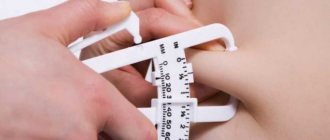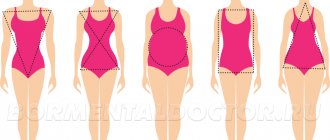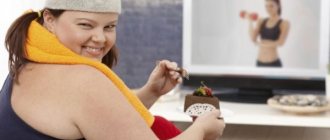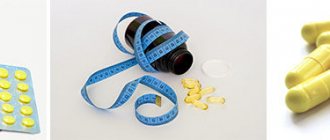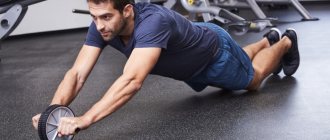Body mass index
Quetelet index (body mass index, BMI ) is a more progressive option. The body mass index indicator was developed by the Belgian sociologist and statistician Adolphe Quetelet in 1869.
BMI = weight (kg) / [height (m)]2 For example, a person’s weight = 60 kg, height = 170 cm. Therefore, the body mass index in this case is equal to: BMI = 60: (1.70 × 1.70) = 20.7 The results are compared with the tabular data.
In accordance with WHO recommendations, the following interpretation of BMI indicators has been developed:
| Body mass index | Correspondence between a person's mass and his height |
| 16 or less | Severe underweight |
| 16—18,5 | Insufficient (deficit) body weight |
| 18,5—24,99 | Norm |
| 25—30 | Excess body weight (pre-obesity) |
| 30—35 | Obesity of the first degree |
| 35—40 | Obesity of the second degree |
| 40 or more | Obesity of the third degree (morbid) |
The body mass index should be used with caution, solely for indicative assessment - for example, an attempt to evaluate the physique of professional athletes with its help may give an incorrect result (a high index value in this case is explained by developed muscles).
The effect of weight on health
Doctors often warn about the harmful effects of excess weight on health, which has been confirmed by many years of observations.
Its excess leads to the following diseases:
- hypertension;
- diabetes;
- atherosclerosis;
- arthritis or arthrosis;
- stroke;
- heart attack;
- colorectal or breast cancer.
In addition, studies have shown that excess weight affects life expectancy. It is highest in people with a BMI approaching 26.
All of these diseases can lead to serious consequences, because... Excessive obesity increases the load on the cardiovascular system, joints and pancreas.
Being underweight is also harmful. Often it is a symptom of a disease or excessive stress, an irrational diet.
Excess body weight can cause many health problems.
Low weight causes decreased immunity, endocrinological problems, deterioration of reproductive function, and psychological disorders. People who are underweight may experience kidney prolapse, gout, or urolithiasis. People who are underweight are constantly cold because their body's ability to maintain a constant body temperature is impaired.
The goal of achieving an ideal weight
To prevent health problems, you need to maintain your body weight within established limits.
For girls, not only health is important, but also aesthetic satisfaction from their own appearance, the approval of others, and the absence of social discrimination.
Broca's formula
Ideal weight for men = (height in centimeters – 100) · 1.15. Ideal weight for women = (height in centimeters – 110) · 1.15.
Example: Ideal weight for a woman 170 cm tall = (170 – 110) · 1.15 = 69 kg.
Broca-Brugsch formula
The previous formula was modified taking into account body type and non-standard height.
So, hypersthenics add 10% to the form, and asthenics subtract 10%. As for height, now it is proposed to calculate as follows (X is height in centimeters): less than 165 cm: X - 100 165-175 cm: X - 105 more than 175 cm: X - 110.
Already in this form the result is more optimal. So, a girl with a normosthenic physique and a height of 168 cm should weigh: 168-105 = 63 kg.
How to determine your body type
To determine a woman's body type, it is necessary to measure the wrist at its narrowest point.
- A wrist less than 14 cm means that you are asthenic.
- A wrist from 14 to 18 cm indicates that you are normosthenic.
- A wrist of 18 and above indicates that you are a hypersthenic.
Men will have different results:
- less than 17 cm is an asthenic type
- from 17 to 20 cm - normosthenic type
- more than 20 cm - hypersthenic type
You can also find out your body type from the ratio of height and leg length . Determine the length of your leg. To do this, ask someone to help you measure the distance from the most protruding point of the hip bone to the floor with a measuring tape. Divide your height in half.
- With the asthenic type, the leg length is 2-4 cm more than half the height.
- With the normosthenic type, the leg length is 4-6 cm more than half the height
- With the hypersthenic type, the leg length is 6-9 cm more than half the height
Other indices for determining normal weight
Breitman index. Normal body weight is calculated using the formula - height [cm] • 0.7 - 50 kg.
Bernhard index. Ideal body weight is calculated using the formula - height [cm] • chest circumference [cm] / 240.
Davenport Index . A person's mass [g] divided by height [cm] squared. An increase above 3.0 indicates the presence of obesity (obviously, this is the same BMI, only divided by 10).
Oder index. Normal body weight is equal to the distance from the crown to the symphysis [cm] • 2 - 100.
Noorden index. Normal weight equals height [cm] • 420/1000.
Tatonya index . Normal body weight = height − (100 + (height − 100) / 20)
In clinical practice, body mass index is most often used to assess body weight.
We must not forget that body weight also depends on a person’s age. The following chart will also help you determine your weight category.
Methods for calculating body fat percentage
Body analysis provides insight into your health.
The methods range from simple and fast to complex and highly accurate. Some calculations cannot be done on your own and require a medical professional to carry out the analysis and interpret the results. The most common methods for calculating body fat percentage are:
- Thickness of the skin fold. A method of measuring subcutaneous fat by pinching the skin and using a caliper to measure the thickness of the skinfold. The measurements are entered into a formula used to estimate body fat percentage. This method is fast, accessible and inexpensive. But its ability to accurately depict overall body characteristics is limited because it only measures subcutaneous fat.
- Bioelectrical impedance analysis (BIA). This method uses electrical impulses to determine your lean body mass level. BIA machines range from simple home scales with electrodes under each foot to more complex devices with electrodes for the arms, legs and other parts of the body. The devices send tiny electrical impulses through the body and measure how quickly they return.
- Underwater weighing. First, the mass is measured outside the water on a scale, then determined when a person is completely immersed under water. Because muscle tissue is denser than fat tissue, the difference in weights can be used to determine body density. The accuracy and reliability of this method are high, but it is not always accessible and convenient.
- Air displacement plethysmograph. The air displacement method for assessing body composition is a more recent development. Using a similar principle to underwater weighing, the device, called BodPod, measures body weight and air displacement to determine body density. It then calculates body composition and indicates the percentage of lean body mass and fat mass. It is fast, safe and accurate, but requires access to a machine and an experienced physician.
- Ultrasound. Used for accurate assessment of adipose tissue. The portable device is capable of quickly assessing body composition. The method is reliable and accurate.
Weight table of academician A.A. Pokrovsky
You can also use a table developed by the Soviet biochemist, academician A.A. to determine normal body weight, taking into account gender, age and body constitution. Pokrovsky Normal body weight at the age of 25-30 years (according to A. A. Pokrovsky)
| Height cm | Men, kg | Height cm | Women, kg | ||||
| Narrow chest | Normal rib cage | Wide chest | Narrow chest | Normal rib cage | Wide chest | ||
| 155.0 | 49.30 | 56.00 | 62.20 | 152.5 | 47.80 | 54.00 | 59.00 |
| 157.5 | 51.70 | 58.00 | 64.00 | 155.0 | 49.20 | 55.20 | 61.60 |
| 160.0 | 53.50 | 60.00 | 66.00 | 157.5 | 50.80 | 57.00 | 63.10 |
| 165.0 | 55.50 | 61.70 | 68.00 | 160.0 | 52.10 | 58.50 | 64.80 |
| 162.5 | 57.10 | 63.50 | 69.50 | 162.5 | 53.80 | 60.10 | 66.30 |
| 167.5 | 59.30 | 65.80 | 71.80 | 165.0 | 55.30 | 61.80 | 67.80 |
| 170.0 | 60,50 | 67.80 | 73.80 | 167.5 | 56.60 | 63.00 | 69.00 |
| 172.5 | 63.30 | 69.70 | 76.80 | 170.0 | 57.80 | 64.00 | 70.00 |
| 175.0 | 65.30 | 71.70 | 77.80 | 172.5 | 59.00 | 65.20 | 71.20 |
| 180.0 | 68.90 | 75.20 | 81.20 | 175.0 | 60.30 | 66.50 | 72.50 |
| 182.5 | 70.90 | 77.20 | 83.60 | 177.5 | 61.50 | 67.70 | 74.90 |
| 185.0 | 72.80 | 79.20 | 85.20 | 180.0 | 62.70 | 68.90 | 73.70 |
Note. At the age of over 30 years, it is permissible to increase weight compared to the table for men by 2.5 - 6 kg, for women - by 2.5 - 5 kg.
Egorov-Levitsky table
The table shows the maximum weight for this height.
Maximum permissible body weight
| Height, cm | 20–29 years old | 30–39 years old | 40–49 years old | 50–59 years old | 60–69 years old | |||||
| husband. | wives | husband. | wives | husband. | wives | husband. | wives | husband. | wives | |
| 148 | 50,8 | 48,4 | 55 | 52,3 | 56,6 | 54,7 | 56 | 53,2 | 53,9 | 52,2 |
| 150 | 51,3 | 48,9 | 56,7 | 53,9 | 58,1 | 56,5 | 58 | 55,7 | 57,3 | 54,8 |
| 152 | 51,3 | 51 | 58,7 | 55 | 61,5 | 59,5 | 61,1 | 57,6 | 60,3 | 55,9 |
| 154 | 55,3 | 53 | 61,6 | 59,1 | 64,5 | 62,4 | 63,8 | 60,2 | 61,9 | 59 |
| 156 | 58,5 | 55,8 | 64,4 | 61,5 | 67,3 | 66 | 65,8 | 62,4 | 63,7 | 60,9 |
| 158 | 61,2 | 58,1 | 67,3 | 64,1 | 70,4 | 67,9 | 68 | 64,5 | 67 | 62,4 |
| 160 | 62,9 | 59,8 | 69,2 | 65,8 | 72,3 | 69,9 | 69,7 | 65,8 | 68,2 | 64,6 |
| 162 | 64,6 | 61,6 | 71 | 68,5 | 74,4 | 72,7 | 72,7 | 68,7 | 69,1 | 66,5 |
| 164 | 67,3 | 63,6 | 73,9 | 70,8 | 77,2 | 74 | 75,6 | 72 | 72,2 | 70 |
| 166 | 68,8 | 65,2 | 74,5 | 71,8 | 78 | 76,5 | 76,3 | 73,8 | 74,3 | 71,3 |
| 168 | 70,8 | 68,5 | 76,3 | 73,7 | 79,6 | 78,2 | 77,9 | 74,8 | 76 | 73,3 |
| 170 | 72,7 | 69,2 | 77,7 | 75,8 | 81 | 79,8 | 79,6 | 76,8 | 76,9 | 75 |
| 172 | 74,1 | 72,8 | 79,3 | 77 | 82,8 | 81,7 | 81,1 | 77,7 | 78,3 | 76,3 |
| 174 | 77,5 | 74,3 | 80,8 | 79 | 84,4 | 83,7 | 83 | 79,4 | 79,3 | 78 |
| 176 | 80,8 | 76,8 | 83,3 | 79,9 | 86 | 84,6 | 84,1 | 80,5 | 81,9 | 79,1 |
| 178 | 83 | 78,2 | 85,6 | 82,4 | 88 | 86,1 | 86,5 | 82,4 | 82,8 | 80,9 |
| 180 | 85,1 | 80,9 | 88 | 83,9 | 89,9 | 88,1 | 87,5 | 84,1 | 84,4 | 81,6 |
| 182 | 87,2 | 83,3 | 90,6 | 87,7 | 91,4 | 89,3 | 89,5 | 86,5 | 85,4 | 82,9 |
| 184 | 89,1 | 85,5 | 92 | 89,4 | 92,9 | 90,9 | 91,6 | 87,4 | 88 | 85,9 |
| 186 | 93,1 | 89,2 | 95 | 91 | 96,6 | 92,9 | 92,8 | 89,6 | 89 | 87,3 |
| 188 | 95,8 | 91,8 | 97 | 94,4 | 98 | 95,8 | 95 | 91,5 | 91,5 | 88,8 |
| 190 | 97,1 | 92,3 | 99,5 | 95,6 | 100,7 | 97,4 | 99,4 | 95,6 | 94,8 | 92,9 |
Many consider this table to be the most comprehensive and balanced approach to determining the presence of excess weight.
Features of determining normal weight for women
Using the Quetelet index Ideal body weight is associated not only with a person’s body type, but also with his age. One of the calculation options is the Quetelet index. So, for example, for girls 15-18 years old it is equal to the following values: for asthenics - 315 g, normosthenics - 325 g, hypersthenics - 355 g for every 1 cm of height. For girls 19-25 years old, the Quetelet index will be equal to, respectively: 325 g, 345 g and 370 g. For women 26-39 years old – 335 g, 360 g and 380 g per 1 cm of height. In addition, for those girls and women whose height is below 1m 60 cm, the weight should be 10-15% less. This is especially necessary for girls under 20 years old.
Lorenz formula Ideal weight of a woman = (height in centimeters – 100) – (height in centimeters – 150) / 2. Or a simplified version: X/2-25, where X is height in centimeters. Example: Ideal weight for a woman 165 cm tall = (165 – 100) – (165 – 150) / 2 = 65 – 15/2 = 57.5. The obvious simplicity of the method has both a positive and a negative side. The Lorenz formula does not differentiate people by type (asthenic, normosthenic, hypersthenic), and does not take into account age and the presence of physical activity. The result can be considered quite average. Please note that this formula was developed only for women and is in no way suitable for the stronger sex. At first glance, it is too demanding on weight compared to the improved Brocca formula and rather indicates exactly the ideal weight when you were eighteen years old. However, it is completely consistent with the body mass index (BMI), so it is quite possible to use it. If you are upset by the proposed numbers, then just forget about it and use another formula. By the way, it still won’t suit women taller than 175 cm
Features of the figure The percentage of fat in a woman's body is of great importance. Trying to create an ideal body, like the professionals, with 5% body fat is unrealistic, since these values are achieved with the help of special diets and special pharmacology. But 10% is ideal. If we compare two girls with the same weight of 60 kg and different percentages of body fat - 10 and 20%, then the first will have 6 kg more muscle tissue than the second. The appearance of both beauties will be strikingly different! If girls with an hourglass figure just need to lose weight so that their ideal body proportions become visible, then “pears” need to focus on strength training in order to slightly build muscle on their narrow shoulders, and “apples” need to give preference to aerobic exercise and exercises for lower body.
Psychologists strongly advise ignoring BMI and other standardized indices. If your reflection makes you happy, but the test showed a slight deviation from the norm, do not be upset about it. It is difficult not to notice excess weight, and a harmonious figure does not require additional confirmation. Use your own common sense when critically assessing appearance. And don't put too much emphasis on dry standard numbers, which are very relative.
Broca's index based on age
Some nutritionists advise taking age into account when making calculations, since in people over 40 years of age, energy consumption decreases, metabolism slows down, and body weight increases. In adolescents, the body is developing, the metabolism is fast, and with a deficit of kilograms, according to the results of standard calculations, the physique itself is normal. You can calculate the correct Broca weight taking into account age by subtracting from height:
- 110 – persons under 40 years of age;
- 100 – for persons over 40 years of age.
Some experts take the limit at 35 years, not 40. The resulting figures are necessarily multiplied by the constitution coefficient. A more accurate calculation option involves reducing the values obtained using the standard formula (adjusted for body type) by 12% for boys and girls under 20 years old, and by 10% for those aged 20-30 years. For people over 50, the result obtained should be increased by 5-7%.


